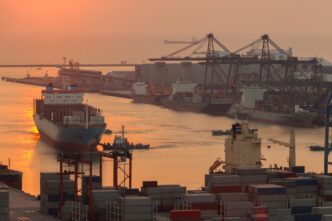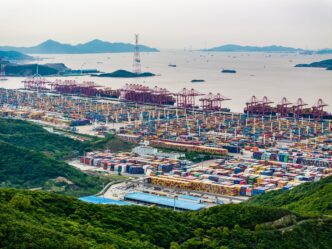Executive Summary
The Story So Far
Why This Matters
Who Thinks What?
Trade between the European Union and its candidate countries, including the Western Balkans, Ukraine, and Moldova, has surpassed €80 billion annually, according to recent data. Despite this significant volume, the economic relationship is characterized by a substantial imbalance, with EU exports heavily outweighing imports from these aspiring member states. This asymmetry highlights that while deep integration efforts are underway, they have not yet fully aligned the economies, underscoring a dynamic of dependence and untapped potential.
Asymmetrical Trade Dynamics
The latest figures reveal a burgeoning trade relationship, yet one marked by an unequal flow of goods. The European Commission’s 2025 Western Balkans trade factsheet indicates total trade in goods between the EU and the six Western Balkan partners reached €83.6 billion in 2024, a 28.6% increase since 2021. EU exports to the region amounted to €49.06 billion, while imports from the Western Balkans were €34.52 billion, resulting in a €14.54 billion trade surplus for the bloc.
The EU’s market dominance is pronounced, accounting for approximately 62% of all Western Balkan trade. Conversely, the region represents a mere 1.7% of the EU’s external trade. For countries such as Serbia, Bosnia and Herzegovina, and Albania, between two-thirds and three-quarters of their total exports are directed to EU countries.
Trade Deficits and Production Structures
Most candidate countries, with the notable exception of North Macedonia, experience persistent trade deficits with the EU, importing more than they export. Branimir Jovanović, an expert with The Vienna Institute for International Economic Studies (WIIW), attributes this to small productive sectors that do not generate enough goods for domestic needs or export.
North Macedonia stands out due to its role as a production base for components integrated directly into EU industry, benefiting from preferential market access under the Stabilisation and Association framework (SAA). This contrasts with Albania, which relies on raw materials and low-value textiles, or Montenegro, a tourism-heavy and import-dependent economy. Bosnia and Herzegovina and Serbia typically import higher-value machinery from the EU while exporting a more mixed, lower-value basket of goods.
Similarly, Ukraine and Moldova import high-value EU machinery, vehicles, and industrial equipment. Their exports primarily consist of lower-margin goods, such as raw materials and basic products, with the EU supplying the technology required for production.
Barriers to Trade and Convergence Challenges
The Western Balkans engage in trade with the EU under SAAs, which aim to gradually eliminate tariffs and align national laws with EU regulations as part of the accession process. Ukraine and Moldova operate under Deep and Comprehensive Free Trade Areas (DCFTAs), which offer broader access to the EU single market in exchange for adopting much of the bloc’s regulatory framework. The distinction between these frameworks has blurred, particularly since 2022, with Brussels indicating a commitment to full membership for Ukraine and Moldova.
Beyond tariffs, candidate countries face numerous technical barriers to trade, such as phytosanitary standards, which can prevent their products from reaching EU markets even when demand exists. Jovanović warns that this situation contributes to a risk of a “middle-income trap,” where economies remain focused on assembly-line production, characterized by low wages and limited technological development and innovation.
The OECD’s Economic Convergence Scoreboard for 2025 highlights that while the Western Balkans have more than doubled their output in two decades, the region still only reaches about 40% of the EU average output per person. At current growth rates, full convergence is not projected until 2074. This indicates a need for qualitatively different growth driven by innovation, skills, and higher-value industries, rather than relying solely on increased output.
Infrastructure and productivity remain critical weaknesses in the region. Inadequate transport networks, for instance, can significantly hinder the connectivity of producers and consumers to global and regional markets. Ukraine’s economy, despite adapting to substantial shocks, faces staggering damage, with public finances stretched by defence needs, further impeding its convergence with EU member states.
Foreign Direct Investment and Structural Transformation
Foreign direct investment (FDI) plays a significant role in bringing factories and jobs to candidate countries, strengthening links with EU member states. However, Jovanović suggests that FDI has not consistently led to “structural transformation” in these nations. In Serbia, for example, car plants boost employment, but the country continues to import high-tech machinery.
When FDI is concentrated in lower-value stages of production and local supplier bases remain underdeveloped, wage gains are limited, and a greater share of value is captured abroad. Jovanović advocates for a change in the economic model, urging a more selective approach to FDI that prioritizes high-quality and high-tech investments, alongside a stronger focus on domestic companies through industrial and innovation policies.
Without such a shift, candidate countries risk remaining assembly platforms rather than evolving into full partners within Europe’s value chains, limiting their long-term economic development.
The Path Ahead
The current economic landscape for the EU and its candidate countries presents a duality: a success story in terms of increased trade and integration, yet a warning regarding the absence of fundamental economic transformation. While exports are rising and factories are operational, productivity and infrastructure continue to lag behind EU standards. Experts suggest that the next phase of integration must prioritize quality over mere quantity.
This necessitates a strategic approach focusing on selective FDI that upgrades supply chains, targeted single-market access linked to structural reforms, and accelerated investment in skills, energy, and transport infrastructure. Should Brussels and the candidate countries effectively transition from an assembly-based model to one driven by innovation, the economic gap could narrow within a generation. Otherwise, these aspiring members risk remaining dependable workshops rather than prosperous and fully integrated partners.








